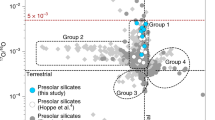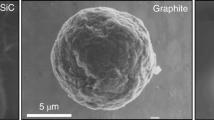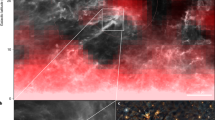Abstract
HUFFMAN1 has shown that absorption bands in the optical spectra of the supernova in NGC 4496 correlate well with d–d bands of Fe3+ in yttrium iron garnet and Fe2+ in terrestrial almandine, Fe2+3 Al3+2Si3O12. I have suggested2 that the 4430 Å band in supernova spectra is a result of Fe3+ in a silicate matrix, the band being reminiscent of that marking the 6A1(S)→4A14E(G) transition in octahedral Fe3+ in andradite garnet, Ca2+3Fe3+2Si3O12. It is likely that interstellar garnets are silicate-based, and here I propose approximate formulae for these garnets based on the identification of two interstellar absorption bands, the energies of which can be related to garnet compositions.
This is a preview of subscription content, access via your institution
Access options
Subscribe to this journal
Receive 51 print issues and online access
$199.00 per year
only $3.90 per issue
Buy this article
- Purchase on Springer Link
- Instant access to full article PDF
Prices may be subject to local taxes which are calculated during checkout
Similar content being viewed by others
References
Huffman, D. R., Nature, 225, 833 (1970).
Manning, P. G., Nature, 226, 829 (1970).
Berkes, J. S., Monograph No. 2, Materials Research Laboratory (Pennsylvania State University).
Cotton, F. A., and Wilkinson, G., Advanced Inorganic Chemistry, 841 (Interscience Publishers, New York, 1964).
Keester, K. L., and White, W. B., Proc. Fifth Intern. Mineralogical Assoc. Meet., Cambridge, 22 (1966).
Jorgensen, C. K., Prog. Inorganic Chemistry, 4 (Wiley, New York, 1962).
Jorgensen, C. K., Structure and Bonding, 1, 1 (Springer-Verlag, Berlin, 1966).
Manning, P. G., Canad. Mineral. (in the press).
Moore, C. E., Nat. Bur. Stand. Circ., 2, 467 (1952).
Manning, P. G., Canad. Mineral., 9, 723 (1968).
Gibbs, G. V., and Smith, J. V., Amer. Mineral., 50, 2023 (1965).
Abrahams, S. C., and Geller, S., Acta Cryst., 11, 437 (1958).
Howie, R. A., and Woolley, A. R., Min. Mag., 36, 775 (1968).
Ito, J., and Frondel, C., Amer. Mineral., 52, 773 (1967).
Faye, G. H., and Hogarth, D. D., Canad. Mineral., 10, 25 (1969).
Burns, R. G., and Strens, R. G. J., Min. Mag., 36, 204 (1967).
Ford, W. K., and Rubin, V. C., Proc. Astron. Soc. Pacific., 80, 466 (1968).
Bloch, M., Chalonge, D., and Dufay, J., Ann. d' Astrophys., 24, 315 (1964).
Fleischer, M., Amer. Mineral., 22, 751 (1937).
Manning, P. G., and Townsend, M. G., J. Phys. C: Solid St. Phys., 3, L14 (1970).
Hartman, P., Min. Mag., 37, 366 (1969).
Author information
Authors and Affiliations
Rights and permissions
About this article
Cite this article
MANNING, P. Compositions of Garnets in Interstellar Dust. Nature 227, 1121–1123 (1970). https://doi.org/10.1038/2271121a0
Received:
Revised:
Issue Date:
DOI: https://doi.org/10.1038/2271121a0
This article is cited by
-
Origin of broad interstellar feature at 1.6 µm−1
Nature (1975)
-
Origin of the diffuse interstellar absorption bands
Astrophysics and Space Science (1975)
-
Ferric Oxide (α-Haematite?) in Interstellar Dust
Nature Physical Science (1973)
-
Accretion and electrostatic interaction of interstellar dust grains; Interstellar grit
Astrophysics and Space Science (1973)
-
Trivalent Transition-Metal Ions in Interstellar Dust
Nature Physical Science (1972)
Comments
By submitting a comment you agree to abide by our Terms and Community Guidelines. If you find something abusive or that does not comply with our terms or guidelines please flag it as inappropriate.



